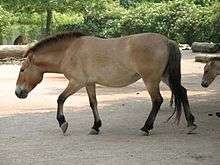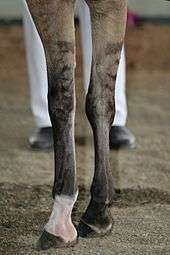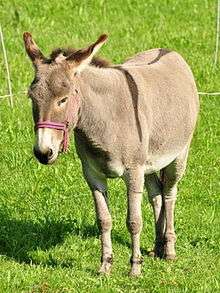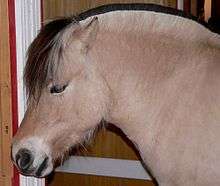Primitive markings
Primitive markings are a group of hair coat markings and qualities seen in several equine species, including horses, donkeys, and asses. In horses, they are associated with primitive breeds,[1] though not limited to such breeds. The markings are particularly associated with the dun coat color family.[2] All dun and non-dun 1 horses possess at least the dorsal stripe,[1][2][3] but the presence of the other primitive markings varies. Other common markings may include horizontal striping on the legs, transverse striping across the shoulders, and lighter guard hairs along the edges of a dark mane and tail.

Origin

The dun coat and attendant primitive or "dun factor" markings reflect the wild type coat and are observed in all equine species.[3] Cave paintings depict horses as being dun and with the primitive markings. The Przewalski's horse, once considered to be the last remaining true wild horse, is also dun-colored with primitive markings, though its domesticated ancestors the Botai horses are found to also have carried Leopard [4]. So, too, are horse breeds such as the Konik and the Heck horse, "bred back" to resemble the now-extinct tarpan, many of which are grullo or mouse dun in color.
While no dun horse is without a dorsal stripe, primitive markings also sometimes occur on horses of other colors, particularly those with sooty characteristics and newborn foals.[1] Primitive markings in horses are an example of atavism: preservation of or reversion to ancestral type. While primitive markings are closely linked with the dun coat colors, the variations of expression and presence in non-dun horses suggest that the markings themselves may be governed by a separate genetic mechanism.[1][5]
Dorsal stripe


Of equids other than horses, all except the mountain zebra show a distinct dorsal stripe. Among domesticated donkeys, most have a black dorsal stripe, though it can be difficult to see on melanistic individuals.[5] In the African wild ass, the dorsal stripe is thin but distinct and black. In Przewalski's horse, the dorsal stripe is usually dark brown, while it is black in the bred-back tarpan. In the plains zebra, the dorsal stripe is narrow and edged by white, while in Grevy's zebra, it is quite bold. The dorsal stripes of the onager and kiang are dark brown and especially vivid.
The dorsal stripe reflects the original coat color of the horse. Those on bay duns may be black or reddish,[5] while those on red duns are distinctly red. Dorsal stripes on dun horses with the cream gene seem unaffected by cream: smoky black-duns ("smoky grullas"), buckskin-duns ("dunskins"), and palomino-duns ("dunalinos") have black, brown, or red dorsal stripes, as well. So-called "countershading dorsals", which are dorsal stripes occurring on non-dun horses, are a darker shade of the horse's coat color.[5] Countershading dorsal stripes may be seasonal, waning, or disappearing altogether during a particular time of year.
Leg bars and markings

Also called zebra bars, tiger stripes,[6] or garters, leg bars are the most common accessory to the dorsal stripe.[1] Leg bars are most commonly seen on or above the knees and hocks, and reflect the underlying coat color. Leg bars on bay duns are black within the points, and reddish above them.[7]
Leg bars are prominent on Grevy's zebras and mountain zebras, and African wild asses also have well-defined black leg bars below the forearm and gaskin on a white or pale background. However, as in horses, expression of leg bars seems to vary widely among donkeys, plains zebras, and Przewalski's horses, while they appear very seldom or not at all in onagers and kiangs.
Leg markings may also take the form of blotches, patches, marbling, mottling, or spotting.[1]
Shoulder stripe

The shoulder stripe is a transverse or "vertical" marking that usually crosses the withers and extends down the shoulders.[1][6][7] Donkeys are known for their distinct shoulder stripe, which, when combined with the dorsal stripe, is sometimes called a "cross". It is more marked in breeds closest to the wild African ancestors of the domestic donkey.[8] Indistinct or poorly defined markings in these regions are often called neck or shoulder smudges, patches, or shadows. Especially large markings are called neck or shoulder capes.[7] The kiang exhibits some shoulder smudging.
Other markings

Less common primitive markings include vertically oriented markings which may be arranged as bars, fine striping, or smudges. Such markings include:
- Dorsal barbs are suggestions of vertical striping on either side of the dorsal stripe.[1][5] They may be so closely placed that they resemble secondary dorsal stripes. Dorsal barbs are also called fishboning.[9]
- Rib marks are extended, perhaps interrupted dorsal barbs.[5] They are usually fine, faint stripes and may be responsible for some horses classified as brindle.
- A ventral stripe runs along the midline of the underbelly of the horse. They are usually wide and are uncommon.[7]
- Zippers are lines of paler hairs running vertically along the back of the animal's leg, usually from the hoof to the knee.[10] Because they consist of paler hairs and are found where horses often have feathering, zippers are considered by some to be guard hairs.
- Bider markings are only known in Przewalski's horses and native Mongolian horses from nearby. The bider is mostly symmetrical and found near the front of each shoulder, near the chest. The size of the bider ranges from a small dark spot to a large, webbed cape of darker skin and hair.[11]
Head markings
Many primitive markings may occur on the animal's head.
- Cobwebbing, also called spiderwebbing, consists of fine, radial stripes on the forehead.[1] Among other equids, cobwebbing is most apparent in zebras.
- Face masks are areas of darker hair on the lower half of the face. These are very common.[7]
- Ear marks are dark markings on the ears, whether the marking involves only the rim, half the back of the ear, or distinct barring or striping on the back of the ear.[7] These are seen almost universally throughout Equus.
- Ear tips are tiny white or paler tips on the ear.[7]
- Eye spots are found around the eyes. They are quite rare, but may be across the eye, over it, or under it.[1][9]
Guard hairs

The dorsal stripe runs through the mane and tail of a dun horse, so the center of the mane and tail are darker. The outer edges may be significantly lighter, even close to white. These paler hairs are seen at the base of the tail and on the edges of the mane. The presence of guard hairs may also be called "frosting".[7] Such characteristics are very visible among the Fjord horses, which have their sandwich-patterned manes shaved short and upright. The presence of paler guard hairs on the mane and tail is seen throughout Equus.
Primitive markings in non-dun horses
Less distinct primitive markings can also occur on non-dun horses, even in breeds which are not known to have any dun individuals. The most common primitive marking found is a dorsal stripe.[1] Most non-dun horses do not have darker primitive markings, but some do. This is because there are two types of non-dun, called non-dun1 and non-dun2. Non-dun 1 removes the diluting effect of dun, but keeps the primitive markings, while non-dun 2 removes both the diluting effect and the primitive markings.[12] The non-dun1 allele is over 40,000 years old, while non-dun2 is relatively recent, and is thought to have first appeared within the past several thousand years.[13]
Dorsal stripes and other primitive markings on non-dun horses are commonly called countershading dorsals.[5] Countershaded animals - be they horses or birds - appear two-dimensional and are much more difficult to see. Primitive markings on non-duns can be seasonal, visible only when the horse is shedding its coat.[14] Such primitive markings also seem to be heritable, as horses with prominent countershading dorsals often produce offspring with the same.[5]
Primitive markings in foals
Many foals, particularly if they are buckskin, smoky black, or black, are born with primitive markings such as dorsal stripes and leg bars that disappear after the foal coat sheds. Such horses are sometimes mistakenly registered as dun. This error seems particularly common in foals that turn gray.[5]
See also
References
- Stachurska, AM (1999). "Inheritance of primitive markings in horses". J. Anim. Breed. Genet. 116: 29–38. doi:10.1111/j.1439-0388.1999.00172.x.
- "Dun Zygosity Test". UC Davis. Retrieved 2008-06-20.
- Lusis, JA (1943). "Striping patterns in domestic horses". Genetica. 23 (1): 31–62. doi:10.1007/BF01763802.
- https://www.independent.co.uk/news/science/horse-origin-mysterious-domestic-dna-analysis-przewalskis-botai-domesticated-a8224121.html
- Castle, Nancy (2008). "Primitive Marking Theory" (PDF). Dun Central Station. Archived from the original (PDF) on May 16, 2008. Retrieved 2008-06-20.
- "Dun". Equine Color. Archived from the original on 2008-05-25. Retrieved 2008-06-20.
- "Adult Markings". Dun Central Station. Archived from the original on October 14, 2008. Retrieved 2008-06-20.
- Roger Blench (2013). Wild asses and donkeys in Africa: interdisciplinary evidence for their biogeography, history and current use. Paper presented at the School of Oriental and African Studies, London, 9 May 2012 (revised version, 2013). Accessed July 2014.
- "Definitions". Dungenes. Archived from the original on 2011-07-26. Retrieved 2010-12-02.
- "Grulla". Dun Central Station. Archived from the original on April 11, 2008. Retrieved 2008-06-26.
"Zippers" on the backs of the fetlocks of dun dilute colored horses is a common sight. When clipped, the light line running up the back of the fetlock will be very crisp.
- Mioko MASUDA; Junko TSUNODA; Hiroko NOMURA; Nami KIMURA; Gombojav ALTANGEREL; Bandi NAMKHAI; Usukhjargal DOLJ; Michinari YOKOHAMA (2007). "New Primitive Marking (Bider) in Mongolian Native Horse and Equus przewalskii". Journal of Equine Science. 18 (4): 145–151. doi:10.1294/jes.18.145. Retrieved 2008-12-19.
- "More about Dun and Primitive Markings". Etalon Diagnostics. Retrieved 2019-04-28.
- Imsland F, McGowan K, Rubin CJ, Henegar C, Sundström E, Berglund J, et al. (February 2016). "Regulatory mutations in TBX3 disrupt asymmetric hair pigmentation that underlies Dun camouflage color in horses". Nature Genetics. 48 (2): 152–8. doi:10.1038/ng.3475. PMC 4731265. PMID 26691985. Lay summary – Science Daily.
- Nancy Castle. "Look-A-Like Collages". Dun Look-A-Likes. Dun Central Station. Archived from the original on October 12, 2008. Retrieved 2008-06-26.
| Wikimedia Commons has media related to Primitive markings. |
